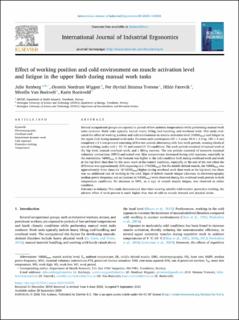| dc.contributor.author | Renberg, Julie | |
| dc.contributor.author | Wiggen, Øystein | |
| dc.contributor.author | Tvetene, Per Øyvind Stranna | |
| dc.contributor.author | Færevik, Hilde | |
| dc.contributor.author | Van Beekvelt, Mireille | |
| dc.contributor.author | Roeleveld, Karin | |
| dc.date.accessioned | 2023-12-10T22:30:46Z | |
| dc.date.available | 2023-12-10T22:30:46Z | |
| dc.date.created | 2021-01-14T09:53:44Z | |
| dc.date.issued | 2020 | |
| dc.identifier.issn | 0169-8141 | |
| dc.identifier.uri | https://hdl.handle.net/11250/3106757 | |
| dc.description | This is an open access article under the CC BY license (http://creativecommons.org/licenses/by/4.0/). | en_US |
| dc.description.abstract | Several occupational groups are exposed to periods of low ambient temperatures while performing manual work
tasks outdoors. Work tasks typically include heavy lifting, tool handling, and overhead work. This study eval uated the effect of working position and cold environment on muscle activation level (%RMSmax) and fatigue in
the upper limb during manual work tasks. Fourteen male participants (25 ± 3 years, 80.9 ± 6.4 kg, 182 ± 5 cm)
completed a 2-h test protocol consisting of five test periods alternating with four work periods, wearing identical
sets of clothing, under cold (− 15 ◦C) and control (5 ◦C) conditions. The work periods consisted of manual work at
the hip level, manual overhead work, and a lifting exercise. The test periods consisted of isometric maximal
voluntary contractions (MVC) and seated rest. Skin temperatures decreased during cold exposure, especially in
the extremities. %RMSmax in the forearm was higher in the cold condition both during overhead work and work
at the hip level than that for the same work in the control condition, especially at the end of the test when the
difference was approximately 25% (equating to 2–3 %RMSmax). For the middle deltoid muscle, the %RMSmax was
approximately three times (or 10 %RMSmax) higher during overhead work than work at the hip level, but there
was no additional cost of working in the cold. Signs of deltoid muscle fatigue (decrease in electromyography
median power frequency and an increase in %RMSmax) were observed during the overhead work periods in both
temperature conditions. No decrease in MVC, as a sign of overall muscle fatigue, was observed in either
condition.
Relevance to industry: This study demonstrated that when wearing suitable cold-weather protective clothing, the
adverse effect of work posture is much higher than that of cold on muscle demand and physical strain. | en_US |
| dc.language.iso | eng | en_US |
| dc.publisher | Elsevier B.V. | en_US |
| dc.rights | Navngivelse 4.0 Internasjonal | * |
| dc.rights.uri | http://creativecommons.org/licenses/by/4.0/deed.no | * |
| dc.subject | Electromyography | en_US |
| dc.subject | Overhead work | en_US |
| dc.subject | Intermittent dynamic work | en_US |
| dc.subject | Cold exposure | en_US |
| dc.subject | Protective clothing | en_US |
| dc.subject | Temperature | en_US |
| dc.title | Effect of working position and cold environment on muscle activation level and fatigue in the upper limb during manual work tasks | en_US |
| dc.type | Peer reviewed | en_US |
| dc.type | Journal article | en_US |
| dc.description.version | publishedVersion | en_US |
| dc.rights.holder | © 2020 The Authors. | en_US |
| dc.source.pagenumber | 8 | en_US |
| dc.source.volume | 80 | en_US |
| dc.source.journal | International Journal of Industrial Ergonomics | en_US |
| dc.identifier.doi | 10.1016/j.ergon.2020.103035 | |
| dc.identifier.cristin | 1871118 | |
| cristin.ispublished | true | |
| cristin.fulltext | original | |
| cristin.qualitycode | 1 | |

